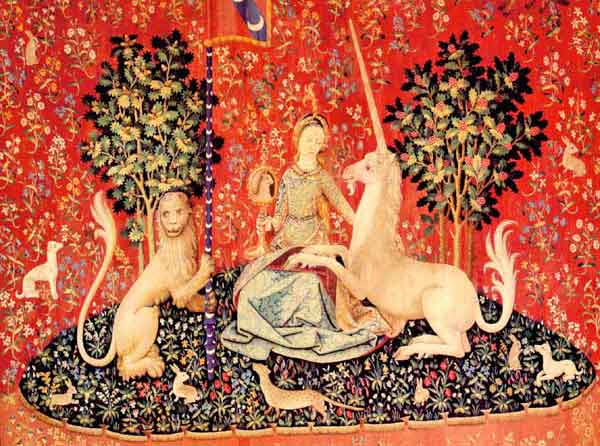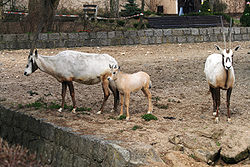Unicorns in Sixteenth-Century Arabia? August 11, 2010
Author: Beach Combing | in : Medieval, Modern , trackback And so we role the dice of history again and this time three words, interesting alone, delectable in combination, appear on the table: ‘Mecca’, ‘unicorn’ and ‘Varthema’.
And so we role the dice of history again and this time three words, interesting alone, delectable in combination, appear on the table: ‘Mecca’, ‘unicorn’ and ‘Varthema’.
Beachcombing will begin with the least known of these words. Varthema, first name Ludovico (c. 1465-1517) was an explorer from Bologna who in the sixteenth century made his way into the Arab world – very probably converting to Islam – and then on into India and finally Burma.
He arrived back in Europe in 1508 and published a description of his voyage in Italian in 1510. It was an enormous success and was rapidly translated into several European languages.
Beachcombing would have a meal with Varthema any day over that tiresome boaster Marco Polo. For, when we can check the accuracy of what Varthema writes, then time and time again his observations are proved to be credible. In fact, he may be that rarest of things, a truth-telling and yet stimulating travel writer.
Among his many achievement was his claim to be the first European from a Christian background to reach Mecca. And in his description of Mecca he gives us the following short chapter: Beachcombing implores the reader to enjoy the understated title. (The original Italian follows on).
The chapter concerning the unicorns in the temple of Mecca, not very common in other places.
In another part of the said temple is an enclosed place in which there are two live unicorns, and these are shown as very remarkable objects, which they certainly are. I will tell you how they are made. The elder is formed like a colt of thirty months old, and he has a horn in the forehead, which horn is about three braccia [arms] in length. The other unicorn is like a colt of one year old, and he has a horn of about four palmi [palms] long. The colour of the said animal resembles that of a dark bay horse, and his head resembles that of a stag; his neck is not very long, and he has some thin and short hair which hangs on one side; his legs are slender and lean like those of a goat; the foot is a little cloven in the fore part, and long and goat-like, and there are some hairs on the hind part of the said legs. Truly this monster must be a very fierce and solitary animal. These two animals were presented to the Sultan of Mecca as the finest things that could be found in the world at the present day, and as the richest treasure ever sent by a king of Ethiopia, that is, by a Moorish king. He made this present in order to secure an alliance with the said Sultan of Mecca.
Capitolo delli Unicorni nel tempio de la Mecha, non molto usitati in altri luoghi.
Da un’ altra banda del dicto tempio è una murata, nella quale sta dentro dui Unicorni uiui , et lì se mostrano per cosa grandissima , come è certo. Li quali dirò come sono facti. El magior è facto como un poliedro de trenta mesi, et ha uno corno nella fronte, el quale corno si è circa tre braccia de longheza. L’ altro Unicorno si è come seria un poliedro de uno anno: et ha un corno longo circa quatro palmi. El colore del dicto animale si è come un cauallo saginato scuro, et ha la testa come un ceruo, et ha el collo non molto longo con alchuna crina rara et curta, che pendeno ad una banda, et ha la gamba sottile et asciuta come un capriolo; el pede suo è un poco fesso dauanti, et 1’ongia è caprina: et ha certi peli dalla banda de drieto de dicte gambe. Veramente questo mostra de essere un ferocissimo, et deserto animale. Et questi dui animali furono presentati allo Soldano della Mecha per la più bella cosa che hoggi se troui al mondo, et per più riccho tesoro, li quali furono mandati da uno Re de Ethiopia, zoè da un Re Moro, el quale li fece questo presente, per fare parentato con el dicto Soldano de la Mecha.
Of course, much has been made of this passage. Here, after all, is a reliable narrator seemingly describing a real life unicorn on the precincts of the Kaaba! It doesn’t get much better than this…
 Karl Shuker, facile princeps in the field of cryptozoology (Casebook, 240-1) suggests that we have here the Oryx leucoryx ‘a handsome creamy white antelope whose two long spiralled horns are so close together that when the creature is viewed in profile it seems only to bear a single central horn.’ But, if this were the case, then Varthema’s claims about the King of Ethiopia must be wrong. The Oryx leucoryx is the Arabian Oryx, which would hardly be exceptional for the locals. Perhaps we are dealing with an African oryx? Nor would Varthema have likely mistaken two horns for one, as his seems to have been a close examination. Would you – see the picture above? Nor finally can this have been a ‘freak’ animal like the Tuscan roe deer presently resident in Prato with a single horn growing from its head (pictured below), for there are two of the Mecca unicorns.
Karl Shuker, facile princeps in the field of cryptozoology (Casebook, 240-1) suggests that we have here the Oryx leucoryx ‘a handsome creamy white antelope whose two long spiralled horns are so close together that when the creature is viewed in profile it seems only to bear a single central horn.’ But, if this were the case, then Varthema’s claims about the King of Ethiopia must be wrong. The Oryx leucoryx is the Arabian Oryx, which would hardly be exceptional for the locals. Perhaps we are dealing with an African oryx? Nor would Varthema have likely mistaken two horns for one, as his seems to have been a close examination. Would you – see the picture above? Nor finally can this have been a ‘freak’ animal like the Tuscan roe deer presently resident in Prato with a single horn growing from its head (pictured below), for there are two of the Mecca unicorns. 
Beachcombing half-heartedly defended the historicity of King Arthur yesterday and frankly that cost him. He is certainly not going to expend energy today claiming that unicorns really existed. But he is confused: what, on earth, did our reliable witness Varthema see? drbeachcombing AT yahoo DOT com
Beachcombing, in any case, got a kick out of the fact that Varthema’s English editor Badger – a bit grumpy most of the time – became a convinced unicorn believer on the basis of the passage above.
The relevant (much cut!) note from Badger follows.
Burton remarks that these animals ’might possibly have been African antelopes, which a lusus naturae had deprived of their second horn, adding, ’but the suspicion of fable remains.’ I [Badger] was inclined, at first sight, to coincide in this opinion, and to conclude that Varthema saw merely two anomalous specimens of the Oryx, by no means an uncommon quadruped on the north-east coast of Africa, judging from the quantity of its horns brought to Aden by the Somalis. On further reflection, however, I am induced to believe that the ’unicorns’ which our traveller describes with so much exactness, and which were ‘ shown as very remarkable objects,’ were living representatives of a species of the antelope family, the existence of which is very generally doubted…Don Juan Gabriel, a Portuguese colonel who lived several years in Abyssinia, assures us, that in the region of Agamos in the Abyssinian province of Damota, he had seen an animal of the form and size of a middle-sized horse, of a dark chestnut-brown colour, and with a whitish horn about five spans long upon the forehead; the mane and tail were black, and the legs short and slender… This account is confirmed by father Lobo, who lived for a long time as a missionary in Abyssinia. He adds, that the unicorn is extremely shy, and escapes from closer observation by a speedy flight into the forests… [There is more in this vein]
While the good reader ponders Badger’s conversion, Beachcombing cannot resist noting the reaction of the population of nearby Medina to an elephant captured from the Persians in 633: ‘The strange animal astonished the simple natives, who asked one another wonderingly, ‘Is this indeed one of God’s works, or did human art make it?’’ (Rawlinson 552).
Did the ‘unicorns’ perhaps elicit similar astonishment when they were unloaded by Ethiopian or Somalian merchants?


